
Historian of Science Paul D. Brinkman studies dinosaurs and the fossils of other very old creatures. He loves natural history museums like Chicago’s Field Museum and North Carolina’s Museum of Natural Sciences, where he works.
What’s the coolest thing you have seen in a museum or found outside?

If you live in the United States, you have probably not encountered a rhinoceros living in the wild. These days, most rhinos are in Africa and Asia. But millions of years ago, rhinos were smaller, with longer legs than their modern descendants have. And they lived on many continents, including North America. Read on to find out how how Paul D. Brinkman, a historian of science, came face to face with an ancient rhino.
”I never took a history class in high school that I didn’t love.” Paul admired each of the history teachers at Lincoln-Way Community High School, in New Lenox, Illinois, south of Chicago. Perhaps this is why he chose a social studies-related college major: physical geography.
The geography department at Augustana College, in northwestern Illinois, was located in the same building as the geology department when Brinkman was a student there. So he found himself hanging out more and more with geology majors, who inspired him to take some courses in their field. The trips students took with their professors for those classes took Brinkman to the Grand Canyon and to more local quarries and caves.
By the time Brinkman was a junior, he wanted to change his major to geology but because it required two years of physics and two of chemistry, he realized he would not be able to finish school in four years… so geology became his minor instead.
“All of the field trips were great,” says Brinkman, who mentioned going to Maquoketa Caves State park, in Iowa. The caves contain ancient burial sites of the Ho-Chunk people — Native Americans whose land was located in many states of the Midwest and is now in Wisconsin and Nebraska.
Brinkman’s favorite field trip sent him and his fellow students to the Grand Canyon. “I think that was the first time that I had been further west than Iowa.” He was “blown away by the scenery…. You can see the rocks. In places I had lived previously, the rocks are covered by top soil and plants and you can see diagrams [of them] but you can’t see [the rocks themselves.]”

Studying geology widened Brinkman’s perspective not only in terms of places he visited but also in terms of time. “I wish more people were familiar with deep time,” he muses. That is, he wishes that more people understood that the history even just of our own planet goes back much, much further than we humans do.
Brinkman teaches a class on deep time, instructing students in how geologic time was discovered and telling the history of planet Earth. This story begins with James Ussher, an Irish archbishop who used the Bible to come up with a date for the formation of our planet. According to his calculations, the world began on October 22nd, 4004 BCE.
How many years ago was 4004 BCE? Today, geologists estimate that Earth is more than four and a half billion years old: the planet formed long before 4004 BCE. But for his time, Ussher’s understanding of astronomy and of the fact that our planet has been around for a long time were pretty sophisticated.
Over time, archaeologists, historians, geologists, and paleontologists collected information that would help us have a more accurate understanding of the planet’s age and its history. They used lava from the volcanoes Mount Vesuvius and Mount Aetna and fossils. And more recently they began to use carbon dating to figure out how old the planet is. Brinkman figured that his students “would find radiometric dating really boring” but discovered that the chemists and physicists taking his classes enjoyed learning about it. In this way, his students are different from young Paul, who preferred studying history to learning math and science.
As a child growing up in Chicago, Paul especially enjoyed visiting the Field Museum. “My mom took us to all the museums in Chicago” and his school also brought Paul and his fellow students to many museums and zoos. So when he finished college, Paul found himself a job at the Field Museum, working with fossils.
At first he worked as a volunteer. That’s when he was invited to join an expedition to the Bridger Basin of Wyoming. Because he was relatively inexperienced in the field and with the western sun, Brinkman was somewhat unprepared and quickly found himself sunburned and dehydrated. He was especially embarrassed when John Flynn, his colleague and mentor, noted that Brinkman had not had much luck finding fossils and asked him whether he was looking down as he walked. “Nothing is more basic in field paleontology than looking down: when your boss asks you if you are looking down, it’s a bad day.”
The group spent four or five weeks exploring the Bridger Basin. The hills they searched were quite eroded — Brinkman says their surface “looked like popcorn.” He walked through the low spots and found broken pieces of fossils: “little bread crumbs” like broken teeth. The teeth were more exciting than bits of bone so he followed them uphill until the trail stopped. Then he dug down and began to expose a bone!

It was one of their last days there, and Brinkman had found the skull of a rhinoceros, “probably the best specimen we collected that summer.” This was what remained of the head of a Hyrachyus eximius, an ancestor of the black rhino called “running rhinos” because they ran across grasslands. The size of large dogs, they were not as massive as today’s African rhinoceroses. Back at the base camp, people were skeptical, asking “Are you sure it wasn’t a turtle shell?”
Brinkman returned to the skull’s location the next day with John Flynn, who helped him finish digging it up and helped carry it back. At the time, they had no Hyrachyus fossils at the Field Museum. “I will never forget finding that specimen.”
Around this time, Brinkman tried out a couple of different graduate school programs. He didn’t find the right field until John Flynn asked him for specific information about what he liked and didn’t like about his studies. “‘It sounds to me like you really like the history of science,’” said Flynn and “Oh my God, you’re right” was Brinkman’s response. Until that point, he had not known that this was a career option but after doing some internet research, he found himself a program at the University of Minnesota and headed there to do a PhD in the history of science and technology.

“I love gathering data,” says Brinkman. He goes to archives to find unpublished papers and the letters scientists exchanged long ago. He also looks through old field notes. “I sometimes spend weeks looking through old papers.” At times he can assume that he’s the first person to look at those papers since the scientist who wrote them died. “Every now and then you find a gem — a letter that solves a burning question or a burning problem that you have in your research.” “There’s nothing as exciting as finding something for the first time.”
Whether being the first to find a rhino skull or the first to discover important clues among a long-gone scientist’s papers, Brinkman enjoys doing detective work.
Do you also love to hunt for previously undiscovered treasures or information? To learn more about this type of work, Brinkman suggests that you check out Jack Horner’s book Digging Up Dinosaurs or Charles Sternberg’s memoir Life of a Fossil Hunter. He’s also a fan of the Jurassic Park movies and Disney’s 1975 film One of Our Dinosaurs is Missing. The dinosaur used for that film was also used in Star Wars.
You might also check out Brinkman’s own book about the period when dinosaurs became especially popular in natural history museums: The Second Jurassic Dinosaur Rush. (Learn more about that book here).


